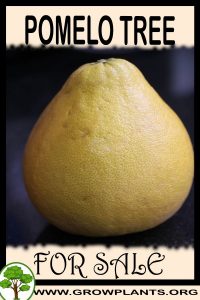
Pomelo tree for sale – Easy plant to grow with edible fruit, planting in early spring to autumn, better to buy grafted tree but also possible tree that wasn’t grafted.
Pomelo tree – information before buying:
Growing information: perennial plant, growing hardiness zone: 9-11, water needed – average to big amount, light conditions – full sun to partial shade, height: 3-7m, 10-23 feet.
Blooming in the winter to spring in cross shaped flowers that appear in white color.
Alternative names: Pomela, Honey Pomelo, Pomelo grapefruit, Pummelo
Pomelo tree for sale
Differences between pomelo and grapefruit – Even if we commonly call it grapefruit, pomelo is not to be confused with grapefruit (Citrus maxima). The grapefruit tree (Citrus maxima) is part of the Rutaceae family, which includes all the other citrus fruits. This shrub finds its origin in Southeast Asia. The fruits, the real grapefruits, therefore, are yellow or greenish, sometimes spherical, sometimes pear-shaped and can be of an impressive size (up to 7 kg!). The pomelo (Citrus x paradisi ), cultivated in all subtropical and tropical zones for its juicy and acidulous fruits, comes from a cross between Citrus maxima and Citrus sinensis ( orange tree ). This shrub can reach 6 meters in height in the ground. It has persistent bright green leaves and divinely scented white flowers in spring. The fruits are round, yellow or pink, and ripen during the winter.
Uses of pomelo – The pomelo is a very beautiful ornamental tree. With its shiny, deep green foliage and its clustered fruits, its balanced shape makes it particularly decorative. It also has a medicinal use: scented flowers can be used, the leaves have an analgesic effect, seeds and pulp are said to cure many diseases. Pomelo juice is said to be a catalyst for certain medicinal substances, increasing their role so much that it sometimes creates an overdose effect.
Cultivars–
- Citrus x paradisi ‘Israeli Marsh’: cultivar with large juicy fruits with slightly bitter yellow flesh.
- Citrus x paradisi ‘Royal seedless’: yellow flesh, soft and sweet; seedless variety.
- Citrus x paradisi ‘Pink Marsh’: pink flesh, sweet but delicately tart.
- Citrus x paradisi ‘Burgundy’: blood grapefruit with dark red flesh, sweet and very fragrant.
Here are some growing tips:
Location – sunny and warm place, sheltered from the wind
Soil – well drained, neutral to acidic pH. For a pot planting, choose a large container with holes at the bottom and drained by a thick layer of clay balls.
Growing in the ground – Choose a tree with rigid foliage, clear green and shiny. Darker veins and yellowing foliage are signs of chlorosis. Look under the leaves for the presence of pests. Dig deep. Remove all weeds and their roots. Add a few shovels of river sand to heavy or clay soil. Bury compost and well- rotted manure. In the soil, plant in the spring when all risk of frost is over. Take the plant out of its container. If necessary, cut the pot. Dig a planting hole large enough to contain the entire root ball. Arrange a bed of 20 cm of gravel at the bottom. Install the tree in the center of the hole and recap by adding a handful of marine bone powder to the ground. Ensure that the grafting point is not buried. Pour a bed of compost at the foot of the tree. Scratch. Dig a bowl around the trunk to retain the water.
Growing in a pot – Fill a large clay pot pierced at the bottom or a large tank without reservation with a thick bed of clay balls or gravel (20 cm).Add a layer of “special citrus” potting soil containing a slow-release fertilizer and a little homemade compost. Install the tree in the center of the pot at a correct height allowing the grafting point to be 5 cm above the ground level. Fill the vacant spaces with this same mixture and pack the soil around the trunk.
Watering – Water regularly and very abundantly the 3 years following its planting in open ground to ensure a good recovery. In winter, water every 2 weeks, only if it doesn’t rain. In a pot, make sure that the mixture never dries completely between two waterings during the growth period, then limit the contributions in winter to one watering every 10 days.
Harvesting – The pomelo is harvested when the fruits have a beautiful yellow color and come off easily. The pomelo doesn’t continue to ripen once it is picked and must therefore be harvested when ripe.
Pruning – Grapefruit pruning is not really necessary, but if you do not prune, your grapefruit should quickly gain a lot of size. To increase the amount of fruits, reduce each new growth by about half, taking care to cut just above a pair of leaves, an eye, a bud. You will also allow your pomelo to maintain a beautiful compact silhouette. You may have to intervene several times a year. Remove the dead wood as you go along and possibly ventilate the inside of the grapefruit to give it light.
Pest and diseases – Red spiders, aphids or white flies but also scale insects are the enemies of the pomelo. They mainly attack the leaves, which lose their color. Mealybugs are the most virulent: they attack the leaves but also the twigs and fruits, leaving gray and sticky traces in their path. Systematically, it is advisable to: clean the pomelo trunk with a brush and clear the soil around the tree, spray a mixture of water and black soap, cut the parts of the tree too overgrown with pests, release ladybugs. The pomelo is susceptible to two diseases: chlorosis and anthracnose. Chlorosis occurs when pomelo leaves turn yellow, except for their veins. It’s often a sign of too calcareous soil. Anthracnose manifests as black spots that invade the foliage.
Categories
| growing |
|
|---|

